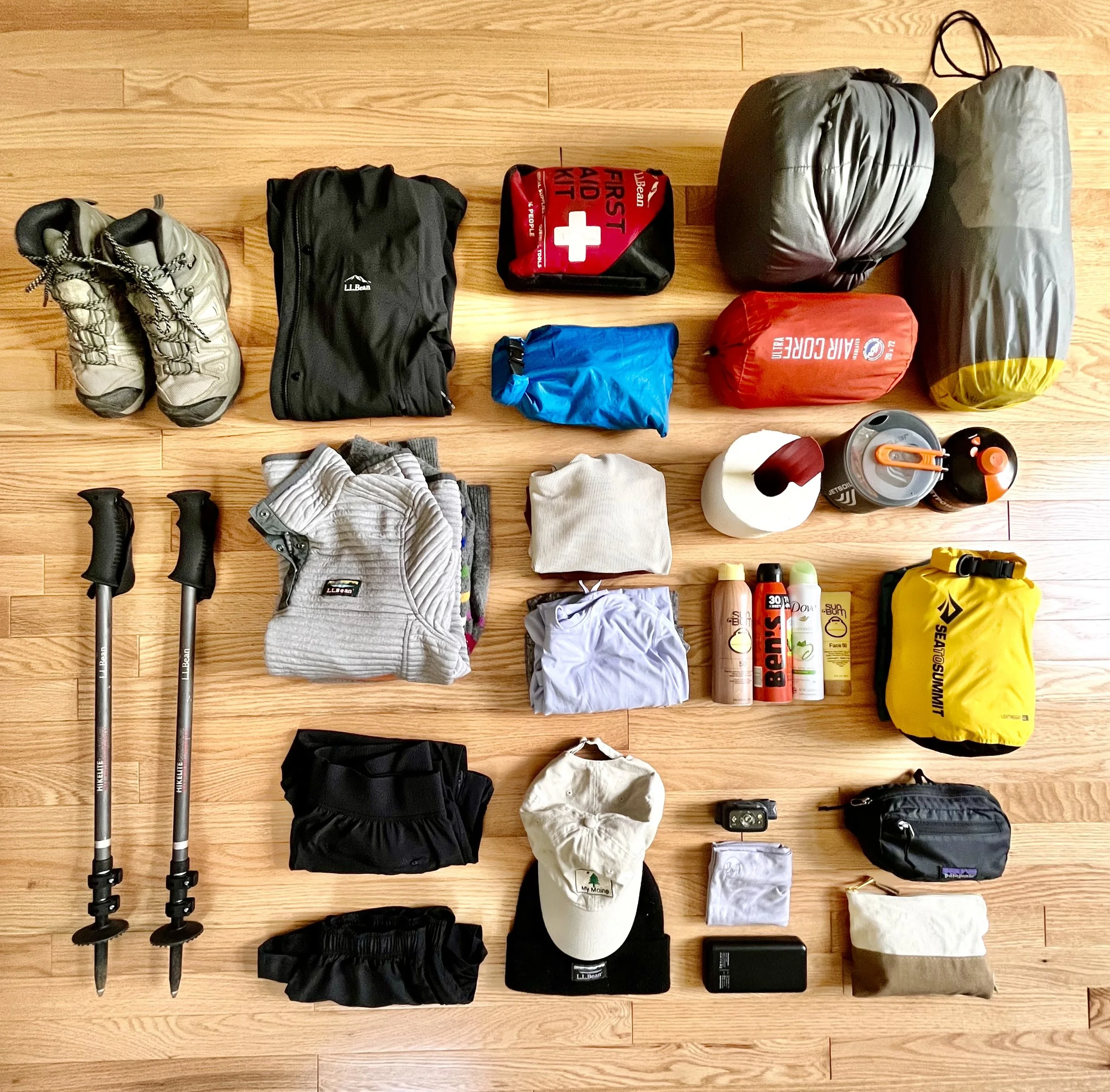Baxter State Park Backpacking Checklist
Hi friends! If you’re in the planning stages of your backpacking trip to Baxter State Park, you’ve come to the right place! I’ve got so much helpful information to share that will help make planning and packing stress-free!
Backpacking in Baxter State Park is no walk in the park (see what I did there?). A lot of people underestimate its severity and end up in dangerous situations because of their lack of research and emergency preparedness. The good news is that you are not one of those people, because you are reading this article! So, let’s get to it!
Disclaimer: This article was created using information from my personal experience hiking in Baxter State Park. I am not a professional guide. This article is not exclusive or perfect. As always, use common sense and best judgement when planning for a trip in the North Maine Woods.
*Some of the links shared in this post may be affiliate links meaning I make a small commission off of your purchase with no extra cost to you. This allows me to continue to create free content for my readers. Thank you for your continued support!
Planning Your Trip
In Baxter State Park, it’s important to plan your trip out weeks or even months in advance. This is largely due to the popularity of the park and the fact that reservations are required for camping, cabins, and hiking any trail on Katahdin. Planning ahead of time is also important because there is no service in the park, so you’ll want to provide an itinerary to a family member or friend in case of emergencies.
Reservations for Baxter are done either over-the-phone or via the Baxter State Park website. These tend to sell-out really quickly, so be prepared to be flexible with your hiking dates. Maine residents can make day-hiking reservations for any day of the season starting April 1st. Non-Maine residents can make day-hiking reservations up to two weeks before your hike. You cannot make more than 3 day hiking reservations per month and each reservation costs $5.00.
If you’re hiking anywhere on Katahdin, parking reservations are required (unless you’re camping at a campground in the park). For example, you do not need parking reservations if you’re camping at Chimney Pond, Abol, or Roaring Brook, or Katahdin Stream. The gate to the park opens at 6:00a.m. and hiking reservations are held until 7:00a.m. Yes, you read that right. 7:00a.m. At 7:05a.m., the rangers will start giving away parking spots to people waiting at the gate. So you can risk it for the biscuit and not make a reservation, but if the trailhead you wanted to hike from fills up, it’s possible you’ll have to change your plans. And if you have a reservation, make sure you’re on time.
It’s also important to note that there are no first-come first-served campsites in Baxter. All campgrounds require reservations. So don’t arrive at the park expecting to be able to set up camp somewhere along the trail. It'‘s not going to happen. Baxter is the most strict State Park in Maine (and they have good reason to be!).
Food
To help keep your pack as light as possible, opt for freeze-dried meals for breakfast and dinner. I gotta say, I was pleasantly surprised by how tasty they are. The texture isn’t always perfect, but the flavors are solid. Also— there are so many options to choose from! Even our friend that has a long list of allergies is able to find freeze-dried meals he could enjoy. My personal favorite freeze-dried meals are the fettuccine alfredo and the beef stew entrees from Mountain House.
For lunch, I opt for protein-heavy bars and snacks like trail mix, granola bars, peanut butter, etc. Uncrustables also make wonderful hiking lunches. Not eating freeze-dried meals for lunch helps me conserve the amount of water I need to carry as well as the amount of time I need to stop for.
For cooking our meals, we have the Jetboil Stash cooking system. It’s super light and compact, making it perfect for our backpacking trips. Fuel canisters have to be purchased separately from the system, but it’s well worth the money—it’ll boil water in just 2.5 minutes!
When backpacking in Maine, another important item is a bear bag like this one. We do have black bears in Maine, specially in Baxter State Park, so it is necessary to bring a bear bag as well as rope to hang your bear bag from either a tree or a bear bag line.
Water/ Water filtration
For hiking any trail on Katahdin, Baxter State Park recommends bringing 2 quarts of water per person. There are several water sources in the park, so you don’t have to worry about bringing 2 or 3 days worth of water in with you. Keep in mind that any water you get from a pond, spring, etc., will need to be filtered. Some examples of places where you can get water: Roaring Brook, Chimney Pond, Basin Ponds, Katahdin Stream, etc. Be prepared and research where you’re going to replenish your water before visiting the park.
I always bring two methods of water filtration. The first is typically iodine tablets, which take about 30 minutes to sterilize your water. The second is the Sawyer Squeeze water filtration system, which requires filling up a large pouch with water and then squeeze it through a filter into a clean bottle or bladder. Or you can screw the filter onto a disposable water bottle and not spend the time squeezing the water into a bottle (which can be very time consuming). Personally, using iodine tablets is my preferred method of water filtration. I find it to be easier, less time consuming, and space-saving.
Gear
Besides food and water filtration, the next most important factor is hiking gear. I’ve found that this largely varies from person to person, so i’m just going to share what I use and leave it at that.
First and foremost, overnight hiking packs. These vary in size, typically holding between 30-60 liters. My go-to for backpacking is my Osprey Eja 48 liter pack that I was fortunate enough to purchase on sale from L.L Bean. My favorite feature of Osprey packs is how well they sit off of your back to promote air ventilation.
Don’t forget to pack hiking poles. They are the true MVP of any backpacking trip. These Hikelite 4-season poles helped me stand upright so I could breathe better. They can be an absolute life saver, especially when it’s hot outside or raining. They also help relieve joint pain. This particular pair only weigh 1 pound 3 oz and can easily strap to your pack when not in use.
Both my husband and I’s hiking boots are Salomon brand and they’ve held up for years. These X Ultra Mid Gore-Tex boots are my go-to summer hiking boot. Honestly, you really can’t go wrong with any of their boots. In my experience, the Gore-Tex boots are lightweight, water resistant, breathable, and have great traction. They pair perfectly with these Darn Tough wool socks.
For sleeping on summer nights, I usually pack my two-person Microlight tent from L.L Bean, my inflatable pillow from Klymit, my Big Agnes insulated sleeping pad, and my 20 degree lightweight down sleeping bag from L.L Bean. If the weather is extremely cold, a bed pad with a higher R-value and a warmer sleeping bag may be necessary. I have never found that to be the case while backpacking anytime between June and September in Maine.
Clothing
It’s hard for me to recommend clothes to pack when everyone’s preferred hiking clothing is so different. So instead, i’ll just share some general guidelines and what I tend to pack.
When backpacking in the summer, I tend to pack clothes that are moisture-wicking, lightweight, and won’t take up much space. For a 3-day backpacking trip, I typically bring: a rain jacket, fleece, wool sweater, swimsuit, two moisture-wicking tank tops, a moisture-wicking t-shirt, a moisture-wicking/SPF 50 long-sleeve shirt, a pair of Nike running shorts, and a pair of moisture-wicking camp pants. I also like to bring 3-4 pairs of darn tough socks, a couple of sports bras, underwear, a beanie, mittens, a deet-treated buff (to help with bugs) and a baseball cap.
I usually pack these things in a dry bag to keep them out of the humidity and rain. Then, i’ll bring an empty dry bag to put my wet/dirty clothes in.
Toiletries/Hygiene Products
This category definitely differs from person to person, but I feel like someone might find it helpful, so i’m going to share what I pack. Of course, you need a roll of toilet paper. I like to keep this in a dry bag along with a lightweight trowel. You usually have to carry out your own toilet paper, so I will bring a gallon size baggie to dispose of my used toilet paper in. Inside that baggie, I will typically put a smaller baggie that has my tampons (if needed) as well as some wet wipes.
In addition, I usually bring: hand sanitizer, deodorant, bug spray, sunscreen, a wide-tooth comb, and some extra hair elastics.
Emergency Supplies
Emergency supplies are arguably the most critical item in your backpack. I find that most people tend to underestimate how dangerous hiking is. Emergencies can happen to anyone at any time. You could fall, twist an ankle, get rained on and develop hypothermia, get attacked by a wild animal, etc. Making it crucial to have emergency supplies on hand.
I always pack my L.L Bean first aid kit, which holds medical and survival supplies for 1-4 people. I also bring emergency blankets, a compass, maps, a small multi-tool, headlamps, a charging bank for my cell phone, a phone charger, identification (my license), some cash, a credit card, extra food, etc. It’s also important to pack items specific to the region you’re hiking. For example: rope to hang your bear bag or sunscreen.
Recreate Responsibly
Make sure you’re realistic in your expectations and listen to your body. If you don’t have a lot of backpacking experience or hiking experience, start with smaller mountains and work your way up to the larger overnight hikes. Backpacking can be both fun and safe if you know what to pack and plan ahead. Always make sure that you pack accordingly, tell people when you’re leaving and when you expect to be back, and most importantly, take hiking seriously. Respect the land, carry in and carry out, and don’t bite off more than you can chew.
Happy hiking, friends!
Please note: outside firewood, dogs, and drones are not allowed in Baxter State Park!

